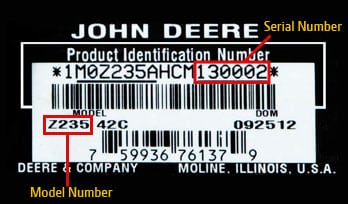
Much of that information appears in “John Deere EK” in the Gas Engine Magazine June/July 2018 issue. Jim White, a well-known John Deere collector and restorer, also gained access to the archives researching the EKs. Figure 3 is a 3EK with its characteristic brass mixer. Just two months later, in June 1926, came the kerosene throttle-governed engines the 1.5, 3, 6EK. The battery engines were followed in April 1926 with the 6hp 6E, finishing out the base Model E line. Figure 2 is a 1924 3E Battery with its distinctive battery box, spark plug and missing magneto. We call them spark plug engines, but John Deere called them battery engines. The first variation to the base Model E was the 1.5 and 3E Battery introduced in 1924. Even the 1.5E pulley bolt pattern was different until December 1922. Looking at Figure 1, a 1922 1.5E, notice a different base, fuel line, fuel tank, igniter, magneto, flywheels, muffler, needle valve, rivet style pushrod pins, etc., when compared to later years. In chronology, it is interesting to note how many changes were made to these engines from 1921 to 1924, and how few changes were made from 1925 until the end of production in 1946.

That was followed in April 1922 with the famous embossed 3hp 3E. John Deere shipped the first enclosed self-oiling engine in June 1921, a 1-½hp Model E (1.5E). Fill out the tractor serial number form with your engine serial number and model information. Rie saved the boring minutiae for this article! For information such as shipping locations and dates of your engines, visit. You will find it an informative overview, yet an armchair reader lacking boring minutiae.

For a detailed description from the oldest known existing Model E to the EP Northern, one of us (David) highly recommends the book John Deere Type E and its Variations by Rie Fulk. Let’s begin with a brief description of the Model E and its variations. We decided to merge the two efforts and make the information available to other serious John Deere collectors and restorers. In the last 40 years, Rie has made several trips to the archives and restored countless engines. The other of us (Rie) learned from his father: “If it’s worth doing it’s worth doing right.”įather and son gained access to the John Deere archives in East Moline, Illinois, and were able to pull serial numbers and decision dates for key milestones enabling Rie to correctly restore early John Deere engines. That timeline was easy to look at to quickly grasp a visual image of when various versions of the Model E were introduced.

One of us (David) had been developing a John Deere engine timeline for many years. This work is the result of two very different efforts. Figure 1: A 1.5E High Base shipped to Minneapolis on June 10, 1922.


 0 kommentar(er)
0 kommentar(er)
